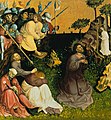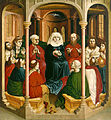Wurzacher Altar
The Wurzacher Altar is a winged altar made in 1437 by Hans Multscher . From the original altar only two wings (canvas on fir wood, each 150 by 140 cm) with two pictures on the inside and outside, so a total of eight picture panels. The name of the altar refers to the art collection of Count Joseph Franz Anton von Waldburg-Zeil-Wurzach in the baroque castle Wurzach , in which the wings were in the 18th century. Today both wings can be seen in the Berlin Gemäldegalerie .
description
The pictures on the Wurzach Altar show four scenes each from the life of Mary and the Passion of Christ. They are arranged chronologically and can be read from left to right. Multscher signed it twice to emphasize it as his own work, because in many writings he is only referred to as a sculptor. In his early work he was committed to the soft style . Later he tried to overcome this with a new realism, which is expressively depicted in the Wurzacher Altar.
The human figure is rendered voluminously by Multscher sculpting the bodies under the robes. The coarseness of the faces suggests physiognomies from the people. On a narrow stage he strives for a realistic representation of the space. The eight panels, along with the Tiefenbronn Altar by Lukas Moser and the works of Konrad Witz, are the strongest testimonies to realistic painting of this time in the Holy Roman Empire .
The Passion Pictures are opened by the "Mount of Olives Scene". While Christ prays, the disciples crouch asleep in the lower left corner of the picture. At the top, the heavily armed henchmen move up with Judas at the head.
In the "Pilatusszene" the bound Christ is led to Pilate by the soldiers. The depiction of the halberds and morning stars reminded the viewers of the time that the mercenaries were armed. Pilate washes his hands as a sign that he is innocent of Jesus' death.
In the "Christ Carrying the Cross" the monumentality of the man of Sorrows carrying the cross is striking. The bar of the cross forms an optical protective wall against the grimacing mob. Even children throw stones at the condemned. In this picture, Multscher's realistic representation is particularly strong.
The "resurrection scene" forms the conclusion of the Passion cycle. Christ rises from the tomb, which is in a rock cave. The right hand is raised in a gesture of blessing, in the left he holds the flag of the cross as a sign of victory over death. The sleeping guards lie in front of the sarcophagus. The artist wants to depict the miracle of the resurrection. The process of getting out through the heavy, tightly closed sarcophagus lid is visualized in that the right leg of the resurrected one, which looks as if it has been amputated, is covered by a red coat. Hans Multscher makes the miracle of the resurrection palpable in an effort to create a realistic representation.
The "birth of Jesus" takes place in a narrow homestead. The stable serves as a background. The swaddled child is half pushed into the manger, where ox and donkey are cooped up to watch. In the field, angels announce the birth of the Savior to the shepherds. The spectators, who are recognizable as contemporaries by their clothing, are separated from the action by a wooden fence.
This is followed by the depiction of the "Adoration of the three wise men from the Orient". The kings, as they are popularly known, bring their gifts to the baby Jesus, followed by numerous servants: gold, frankincense and myrrh. The three number symbolizes the three ages of man and with the colored king the number of the then known continents.
The "outpouring of the Holy Spirit" in the form of a dove shows Mary in the midst of the twelve apostles in a chapel-like room.
The last picture of the cycle of Mary shows the "Death of the Mother of God". The apostles stand around her deathbed. Christ takes the soul of the Mother of God into his kingdom in the form of a small child.
literature
- Hans H. Hofstätter, Late Middle Ages, Naturalis-Verlag Munich.
- Gerda Franziska Kircher, The Truchsessen Gallery. A contribution to the history of German art collecting around 1800. Frankfurt 1979
- Manfred Wundram, Early Renaissance, European Painting in the 15th Century in: Painting of the World, ed. by Ingo F. Walther, Cologne 1999.
- Catalog Gemäldegalerie Berlin, Prestel-Verlag, Munich London New York 2nd edition 2002.
- Jutta Held, Social History of Painting from the Late Middle Ages to the 20th Century / Jutta Held, Norbert Schneider, Cologne Dumont 1993.
- The great lexicon of painting, Georg Westermann Verlag, Braunschweig 1982.
- Johannes Jahn , Wolfgang Haubenreißer: Dictionary of Art (= Kröner's pocket edition . Volume 165). 12th, revised and expanded edition. Kröner, Stuttgart 1995, ISBN 3-520-16512-0 .
- Wilckens / Naredi - Rainer, Outline of Occidental Art History, 3rd edition Stuttgart 2000
Web links
Individual evidence
- ^ Rainald Grosshans: Christ on the Mount of Olives. In: SMB Digital. Retrieved July 14, 2020 .
- ^ Rainald Grosshans: Christ before Pilatus. In: SMB Digital. Retrieved July 14, 2020 .
- ^ Rainald Grosshans: Christ carrying the cross. In: SMB Digital. Retrieved July 14, 2020 .
- ↑ Rainald Grosshans: The Resurrection of Christ. In: SMB Digital. Retrieved July 14, 2020 .
- ↑ Rainald Grosshans: The birth of Christ. In: SMB Digital. Retrieved July 14, 2020 .
- ^ Rainald Grosshans: The Adoration of the Magi. In: SMB Digital. Retrieved July 14, 2020 .
- ↑ Rainald Grosshans: The outpouring of the Holy Spirit / Pentecost. In: SMB Digital. Retrieved July 14, 2020 .
- ^ Rainald Grosshans: The death of Mariae. In: SMB Digital. Retrieved July 14, 2020 .








